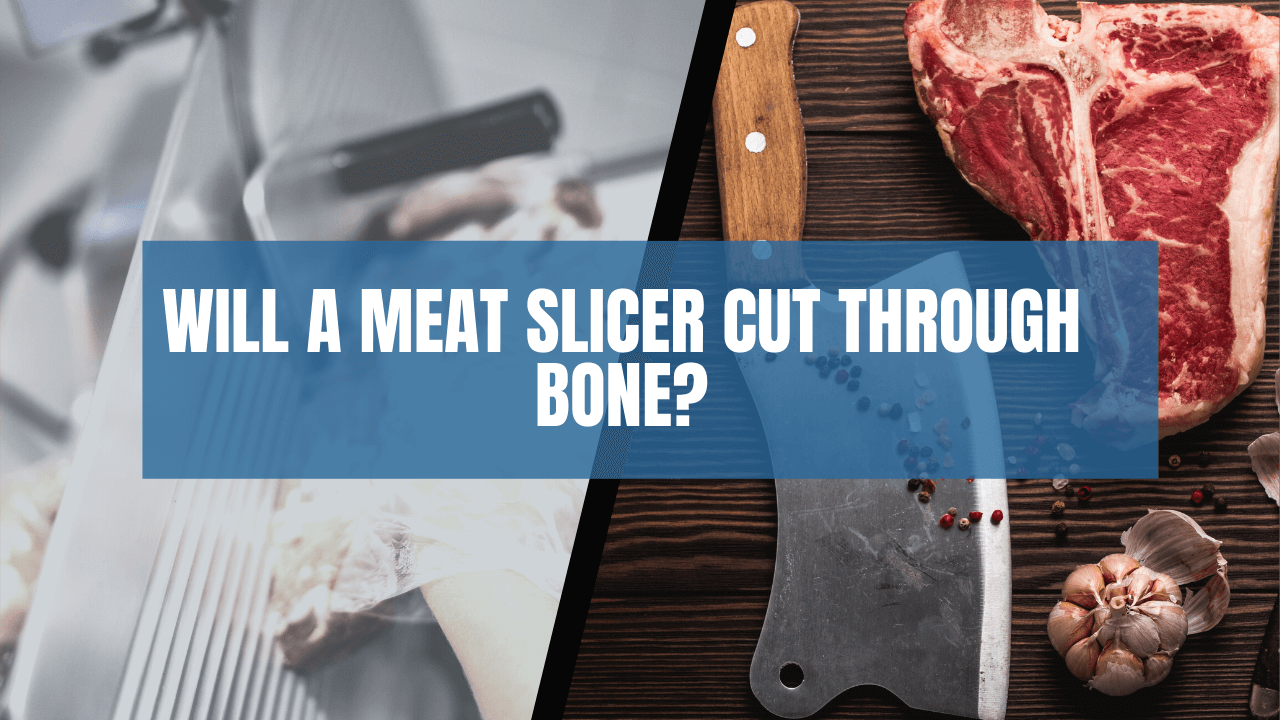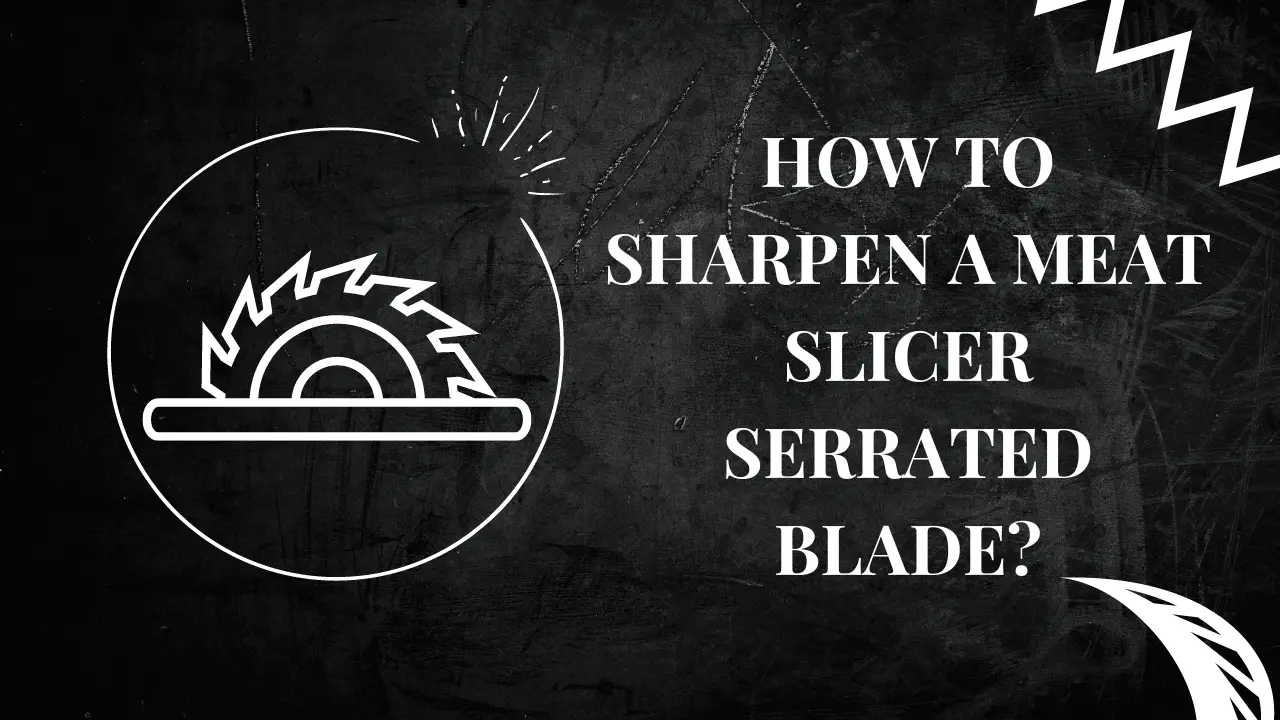Cutting meat like a professional butcher involves combining technique, knowledge, and the right tools. Large chunks of meat can be daunting to handle, but you can cut it easily and precisely with an understanding of the meat’s structure and grain direction. This skill helps portion and prepare your meat for various cooking methods and ensures you get the most out of your purchase. From selecting the appropriate knife to maintaining safety practices, learning to slice through big chunks of meat like a butcher can elevate your culinary skills and create more delicious and well-prepared meals.
Types Of Meat Cuts
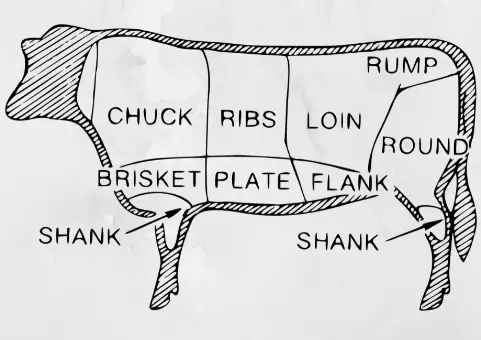
Before diving into the actual meat-cutting process, let’s first look at the different types of meat cuts. Understanding the difference between primal and retail cuts can help you make more informed decisions when purchasing meat.
- Primal Cuts: Primal cuts are large, uncut sections of meat that are usually divided into smaller retail cuts. The four main primal cuts for beef are the chuck, rib, loin, and round. Pork primal cuts include the shoulder, loin, belly, and leg. The primal cuts are the shoulder, rack, loin, and leg for lamb.
- Retail Cuts: Retail cuts are smaller, ready-to-cook pieces of meat from the primal cuts. Examples of retail cuts for beef include ribeye, sirloin, and tenderloin. For pork, retail cuts include pork chops, bacon, and ham. Retail cuts for lamb include lamb chops and leg of lamb.
Equipment Needed
Before you start cutting meat, make sure you have the right equipment. Here are the essential tools you’ll need:
- Cutting board
- Sharp knife
- Meat cleaver
- Kitchen shears
- Meat thermometer
- Butcher’s twine
- Plastic wrap or butcher paper
How To Cut Meat Like A Butcher?
Round
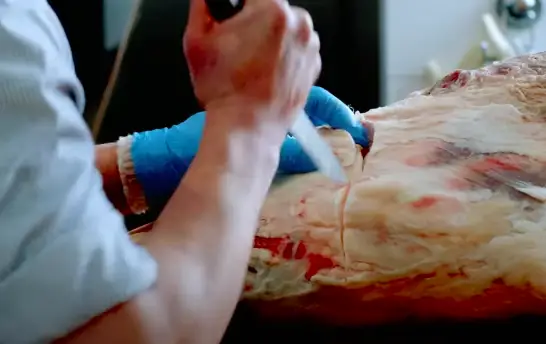
Step 1. Start by cutting your meat with a sharp knife. Use a good-quality chef’s strong and sharp knife to slice through the meat easily.
Step 2. Determine the size of the cut you want to make. Many butchers use a slicing guide to help them determine how thickly or thinly they need to slice.
Step 3. Place the meat on a cutting board and hold it firmly in place. Ensure you keep your fingers away from the blade as you cut.
Step 4. Begin by slicing along one side of the grain, angling your knife slightly away from the center of the meat. Keep your cuts as even as possible.
Step 5. Turn the meat and slice along the opposite side of the grain, angling your knife like before. Keep your cuts consistent.
Step 6. Continue slicing until you have created even-sized slices of the desired thickness or thinness. If your meat has a bone, make sure to cut around it so that you don’t end up with any chunks of bone in your slices.
Step 7. If the cut of meat is large, you may need to use a sawing motion to get through the thicker parts. Make sure to keep your knife at an angle so that it does not slip off the surface of the meat.
Step 8. Once you’ve sliced the entire cut, check that all of your slices are even and of the desired thickness or thinness. If not, you can adjust them as needed before serving.
Step 9: Use a kitchen towel to remove excess juices from the cutting board and knife before storing them. This will help to keep your knife sharp and make it easier to use next time.
The Loin
Step 1. Start by looking for the loin section on your piece of meat. Locate the two long bones that run along the length of it.
Step 2. Place your knife parallel to these bones and cut a few inches over them, following the contours of their shape until you’ve reached the end of the meat.
Step 3. Now, begin slicing by angling your knife slightly away from the bones and cutting towards them at a 45-degree angle while paying attention to the thickness of each slice.
Step 4. Adjust the angle of your blade as you work along so that it is always angled away from the direction you’re cutting. This will help ensure uniform slices.
Step 5. If you’re slicing a larger piece of meat that won’t fit in your cutting board, use a sawing motion with your knife to get through it.
Step 6. Keep your fingers away from the blade and out of harm’s way as you cut.
Step 7. Once you’ve finished, your loin section should be cut into neat slices ready for cooking or eating.
Rib
Step 1. Start with a sharp, flexible meat cleaver. Choose one with a wide blade to cut bones and large chunks of meat.
Step 2. Place the rib of the meat against the cutting board firmly and hold it in place using your thumb and index finger. Make sure that you have a firm grip to avoid slipping.
Step 3. Position the cleaver at a 45-degree angle to the bone and begin cutting with a swift motion. Keep your wrist straight, and don’t twist the knife during this step, as this may cause uneven cuts and make it difficult for you to get through the bone.
Step 4. Once you have cut through the rib, turn the piece of meat over and cut away any excess fat or gristle. Again, this should be done with a swift motion to avoid breaking through the tendons within the meat.
Step 5. Use slow strokes to cut clean slices of meat from the muscle now that it’s been separated from the bone. Make sure that you are cutting across the grain of the meat for a more tender texture, as opposed to cutting with the grain, which will make it tougher.
Chuck
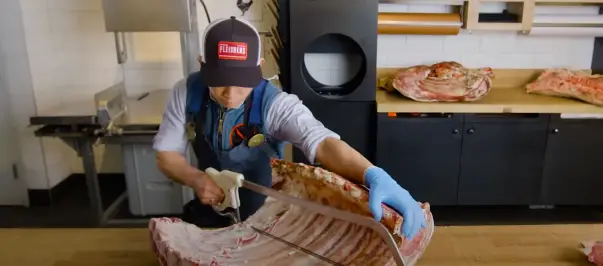
Step 1. Before cutting, freeze the chuck for 15–20 minutes. This will make it easier to carve and help prevent bruising and tearing of the meat while carving.
Step 2. Use a sharp chef’s knife with a long, thin blade to cut through the meat denser than other cuts like steak or ground beef.
Step 3. Cut the chuck into thin, even slices, making sure to slice against the meat’s grain. Slice in one direction first, then turn and cut perpendicularly for thin strips.
Step 4. When cutting boneless pieces of chuck, hold onto a large handle or sturdy surface with your free hand to steady the chuck while carving.
Step 5. Use a sawing motion for larger pieces to cut through the meat gradually and evenly.
Step 6. Remove any excess fat or gristle as you go along, as this can add bitterness to the flavor of the meat and affect its texture when cooked.
Step 7. If necessary, slice the chuck further into smaller pieces that are uniform in size and thickness.
Step 8. Once you’ve finished cutting, wrap the meat securely in plastic wrap before storing it in an airtight container or freezer bag.
Step 9. When ready to cook, let the chuck defrost gradually in the refrigerator overnight. This will ensure optimal flavor and texture.
Tips For Cutting Meat Like A Butcher
- Freeze the meat for 45 minutes so it firms up and is easier to slice through.
- Use a sharp knife with a thin, flexible blade to make slicing easier.
- Cut against the meat’s grain in long, smooth strokes to help create even-sized slices.
- Use the length of your knife to create an even cutting surface by rocking it back and forth while slicing.
- Cut closer to the bone when possible, as this will help you create thinner slices.
- When cutting large chunks of meat, use your knife to separate them into smaller pieces before slicing them for easier handling.
FAQs
What type of knife is best when cutting meat like a butcher?
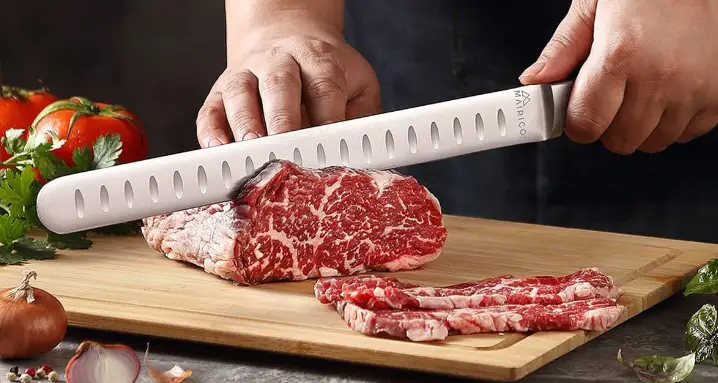
A sharp knife with a thin, flexible blade is ideal for cutting through large chunks of meat. It will make slicing easier and help you create even-sized slices.
How do I ensure that my cuts are even?
Always cut against the meat’s grain in long, smooth strokes. Then, use the length of your knife to create an even cutting surface by rocking it back and forth while slicing. Make sure that you cut through the meat so that your slices are uniform in thickness.
What should I do if I’m having trouble cutting through a tough piece of meat?
Try using a cleaver if you’re having difficulty slicing through a large chunk of meat. The weight and size of the blade will help you cut through more easily.
How can I keep my fingers safely out of the way when cutting?
Place your free hand flat on the meat you cut, but keep your fingers curled and safely out of the way. This will help you control your knife while keeping yourself safe from accidental cuts.
How can I make sure that my slices are uniform in thickness?
Make sure to cut through the meat so that your slices are of even thickness. You can also try cutting closer to the bone, which will help you create thinner slices.
Conclusion

Cutting big chunks of meat can be a daunting task. But with the right techniques, you can easily and quickly slice through any cut of meat like a butcher. Using the correct tools for the job, a sharp chef’s knife is essential. Use an electric knife for larger roasts. Keep your fingers away from the blade, and remember to use a sawing motion when cutting. Start with an even slice parallel to the meat’s grain, then cut against the grain into smaller pieces. Take your time, look at what you’re doing, and be mindful of how thick or thin each piece should be. With practice and patience, you can cut through any chunk of meat like a pro.

Mario Batali is a renowned author, food enthusiast, and passionate chef who has dedicated his life to exploring the world of culinary arts. With a love for sharing his knowledge and experiences, Mario has become a prominent figure in the food blogging community, inspiring countless readers with his creativity and expertise.
In addition to his culinary prowess, Mario Batali is also a talented writer with a flair for engaging storytelling. He launched his own food blog to share his recipes, cooking tips, and personal experiences in the kitchen. Over time, Mario’s blog gained a loyal following of food enthusiasts who appreciate his unique approach to cooking and his dedication to using only the finest ingredients.
Mario Batali’s passion for food and his commitment to sharing his knowledge with others have made him a true inspiration in the world of culinary arts. Through his blog, cookbooks, and public appearances, Mario continues to spread his love of food and the joy of cooking with his ever-growing fanbase.

